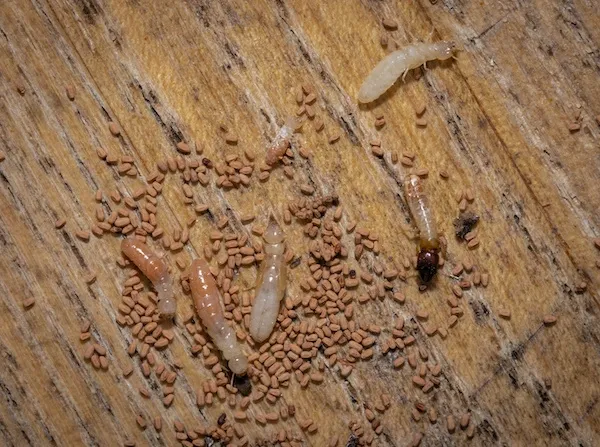Termites, while small in size, wield significant power. These silent invaders can wreak havoc on homes and structures, causing you substantial financial losses.
But how can you stop an infestation before it grows out of control?
Termite droppings, commonly called frass, serve as a significant indicator of a termite presence. These small, wood-colored pellets or powdery substances often mark the initial or only visible sign homeowners notice.
This guide explores termite droppings’ characteristics, their pivotal role in uncovering termite activity, and Absolute Pest Control’s specialized solutions in effectively managing termite infestations.
Termites in Missouri and Kansas
In Missouri and Kansas, two prevalent termite species take the spotlight: subterranean termites and drywood termites. These species exhibit unique behaviors and utilize their droppings in differing ways. These differences are vital for early termite detection and effective termite management strategies.
Subterranean Termites
Subterranean termites, including the Eastern subterranean termites and the Formosan subterranean termites, are formidable pests in Missouri and Kansas, thriving in underground colonies and posing significant threats to structures by voraciously targeting wood and other cellulose-based materials.
A distinctive trait of subterranean termites is their approach to reaching above-ground food sources. They construct mud tubes of soil, wood particles, and fecal matter (frass) to reach your home or other wooden objects.
Employing frass within shelter tubes is a unique strategy for subterranean termites to shield themselves from dehydration and predators while traveling between colonies and food sources.
Unlike drywood termites’ visible pellets, the frass of subterranean termites isn’t typically conspicuous, integrated into the structure of their mud tubes, serving as a critical element for their survival strategy.
Detecting subterranean termites relies less on observing visible frass piles and more on identifying mud tubes, wood damage, or discarded wings near entry points. Recognizing their behaviors and specific traits facilitates early identification and the implementation of suitable management strategies to shield properties from potential damage.
Drywood Termites
Drywood termites, distinct from their subterranean counterparts, establish their colonies within the wood they infest, often targeting structural timber, furniture, or wooden fixtures. Not reliant on contact with soil, these termites forgo the construction of mud tubes.
Instead, drywood termites discard their fecal pellets, known as frass, through tiny kick-out holes near the infested wood. Comprising small, hexagonal-shaped pellets, these deposits originate from the intricate tunnels they carve within the wood.
These termite droppings are typically hard, elongated, and about 1 mm long. They often resemble grains of rice or small, elongated capsules and can vary in color from light beige to dark brown, depending on the wood consumed and the age of the infestation.
Compared to subterranean termites, termite droppings from drywood termites are more conspicuous. Homeowners might discover small accumulations or piles of these pellets near infested wood or beneath the kick-out holes, signifying active termite presence. Recognizing these droppings is a crucial indicator of potential termite activity within the affected area.
Check out this video to see what drywood termite droppings look like up close!
Identifying Droppings and Other Infestation Signs
When investigating a potential drywood termite infestation, maintaining vigilance is critical to identifying their presence. The initial step involves thoroughly observing areas surrounding infested wood or beneath kick-out holes to detect accumulated frass.
These termites expel their droppings through small openings, leading to the gathering of frass below these exits. Scan for small piles or concentrations of frass near wooden structures, furniture, or in secluded spaces such as attics and crawl spaces, favored habitats for drywood termites.
Additionally, be on the lookout for discarded wings near windowsills or doorways, a common indicator as termites discard their wings post-swarming. Examine wooden surfaces for pencil-thin holes close to sites of frass accumulation, which drywood termites create for tunneling. Using a flashlight will help inspect concealed areas where termites might inhabit.
Finally, perform a tap test on suspected infested wood; the termites might knock back, or frass might fall from the holes. Seeking professional inspection services from experts like Absolute Pest Control can provide a thorough and reliable assessment if drywood termite activity is suspected.
Absolute Pest Control: Your Solution to Termite Concerns
Absolute Pest Control is your ultimate solution for termite concerns in Missouri and Kansas. Our specialized services cater to managing termite infestations, providing tailored solutions to address your specific termite problems.
Our team of skilled professionals conducts comprehensive inspections, accurately identifying termite activity and devising highly effective treatment plans. Utilizing advanced techniques and treatments, we ensure the safe and efficient removal of termites from your property.
Our preventive measures are designed to safeguard your homes from future termite threats, offering you long-term protection and peace of mind. Partner with Absolute Pest Control to gain access to specialized expertise and proactive solutions, preserving the integrity of your homes and structures from termite damage.
Contact Absolute Pest Control today and secure your home against termite infestations!

